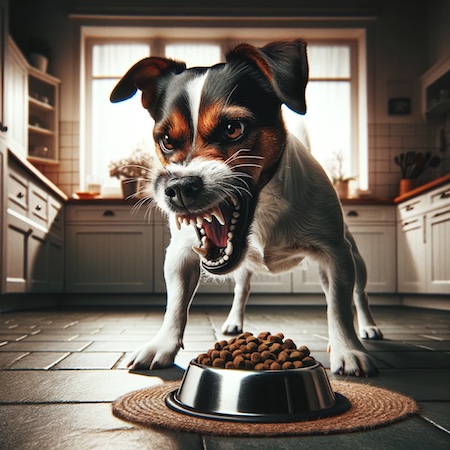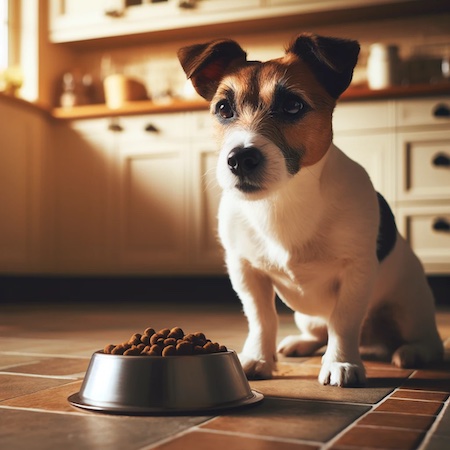Jack Russell Terrier Food Aggression
What is Food Aggression in Jack Russell Terriers?
Food aggression in Jack Russell Terriers manifests as a type of resource guarding behavior where these small yet spirited dogs display aggression around their meals. This can include behaviors like growling, snapping, or even biting if they believe their food is being threatened or if someone comes too close while they are eating. Despite their compact size, Jack Russells are known for their bold and energetic personalities, traits that can also lead them to fiercely guard what they consider theirs.
Search: Hottest Selling Gifts For Jack Russell Terriers
This type of aggression is essentially the dog’s instinctual response to protect an important resource. For Jack Russells, who are naturally tenacious and fearless, the drive to safeguard their food can be strong. They often exhibit a high level of alertness around meal times, ready to defend their food against perceived threats. This guarding behavior is deeply ingrained in their character, reflecting their historical breeding purposes where showing courage and determination were vital traits. Managing this aggression requires careful attention to their environment and consistent training strategies to ensure they feel secure and less driven to guard their meals aggressively.
Why Do Jack Russell Terriers Develop Food Aggression?
Jack Russell Terriers may exhibit food aggression for a variety of reasons related to their genetic predispositions and their environment. These dogs are innately equipped with characteristics that, while advantageous for hunting and tenacity, can lead to protective behaviors over resources like food. Their instinct to guard what they perceive as valuable is often a natural extension of their breeding purpose, which historically involved defending their catches. Without proper guidance and training from a young age, this protective instinct can manifest as food aggression.
Read More: Top 10 Best Rated Dry Food Brands for 2024
The role of early experiences is crucial in the development of these behaviors. Jack Russell puppies competing with siblings for food may adopt more aggressive tactics to ensure they receive their share, which can set a precedent for future food guarding. If these early habits are not proactively managed, they can harden into persistent behaviors.
Inadequate training and inconsistent socialization may also leave Jack Russells uncertain about how to interact with humans and other animals around food, which can escalate to aggressive responses. Additionally, their high energy levels and robust hunting instincts require regular mental and physical engagement; without it, their excess energy may be misdirected into aggressive behaviors around food.
Effective management of food aggression in Jack Russells involves comprehensive training strategies, consistent routines, and ensuring these energetic dogs are well-stimulated and understand that food resources are not under threat. This understanding can significantly mitigate aggressive tendencies and help develop a more relaxed and confident dog. By addressing these root causes and implementing structured interventions, owners can significantly reduce or prevent food aggression, fostering a safer and more harmonious living environment.
The Role of Early Socialization in Prevention
The importance of early socialization in curbing food aggression in Jack Russell Terriers cannot be overstated. By exposing these dogs to diverse and positive interactions, especially during their formative weeks and months, they can learn to cope better with various situations involving food. Effective socialization practices involve more than just introducing them to new people and environments; it also includes creating positive experiences around feeding times.
Incorporating controlled feeding sessions where Jack Russells eat in the presence of people and other pets can be particularly beneficial. These experiences teach them that the presence of others around their food does not pose a threat. It’s important that these sessions are done calmly and without any pressure on the dog. Rewards can be used to reinforce calm and non-aggressive behaviors during these interactions.
Additionally, teaching Jack Russell Terriers to accept treats gently from hands and practicing ‘wait’ commands can further enforce good manners around food. These training exercises help them understand that they don’t need to guard their food aggressively to eat and that behaving calmly will also lead to rewards. Ultimately, thorough and thoughtful socialization can significantly reduce the likelihood of food aggression by helping these spirited dogs feel secure and relaxed around their food resources.
Price: $9.99
11 used & new available from $9.49
Management: Prioritizing Safety
When dealing with food aggression in a Jack Russell Terrier, ensuring the safety of all individuals and pets in the household is critical. One effective strategy is to feed the dog in a separate, secure space where they can eat undisturbed. This arrangement helps prevent any aggressive incidents that could occur if someone inadvertently comes too close during meal times. It’s also crucial to avoid direct confrontations with the dog over food, which could escalate into more severe aggression. Instead, focus on implementing safe, structured strategies that aim to gradually decrease aggressive behaviors around food. Techniques such as feeding by hand to build trust and using positive reinforcement when the dog behaves calmly can be particularly beneficial.
Addressing Resource Guarding Beyond Food
Resource guarding in Jack Russell Terriers often extends beyond food to include toys, sleeping areas, and sometimes even favorite humans. Tackling this broader spectrum of guarding behavior involves a holistic approach centered on enhancing the dog’s trust and shifting their negative perceptions to positive ones when people approach their valued items. Training should focus on positive reinforcement, rewarding the dog for non-aggressive behavior when a person comes near their resources.
Gradual desensitization exercises, where the dog is slowly introduced to having people near their guarded items while maintaining a positive and stress-free environment, can also be very effective. These methods help the dog learn that the approach of humans to their resources does not represent a threat, but rather, it can lead to good things like treats and affection. By consistently applying these techniques, it’s possible to significantly reduce or even eliminate resource guarding behaviors, leading to a more harmonious and safe household environment.
Training: Building Trust and Changing Associations
To effectively reduce food aggression in Jack Russell Terriers, it’s essential to focus on building trust between the dog and its human handlers, while also transforming any negative associations the dog has about human proximity during meals into positive experiences. This training strategy leans heavily on the use of positive reinforcement, rewarding the dog for calm and non-aggressive behavior with treats, praise, or play, which reinforces that human presence is not a threat but a source of good things.
The training process should start with simple steps, such as remaining at a distance while the dog is eating and gradually decreasing that distance over time as the dog becomes more comfortable. This slow approach helps to desensitize the dog to having people nearby when they are vulnerable during feeding. Additionally, you can incorporate exercises like walking past the feeding area without stopping or making eye contact initially, then progressing to more direct interactions such as dropping a favorite treat into their bowl while they eat.
These methods help the Jack Russell Terrier learn through consistent and positive experiences that relinquishing control over their food does not lead to loss but rather benefits. This gradual shift in perspective not only alleviates food guarding behavior but also strengthens the overall bond between the dog and its owners, creating a more trusting and relaxed environment around meal times.
Step-by-Step Training Examples for Managing Food Aggression
Hand Feeding: Start by hand-feeding your Jack Russell Terrier portions of their meals. This method helps to establish a positive connection between human hands and food. Gradually, the dog begins to associate receiving food directly from a person with a rewarding experience, rather than a threatening one.
Approach and Add Technique: During your dog’s mealtime, calmly approach their bowl and add a high-value treat to it, then quietly step back. This exercise teaches your dog that human proximity at mealtime can actually enhance their eating experience, introducing positive reinforcements rather than posing a threat to their food.
Trade-Up Game: Encourage your Jack Russell to willingly give up their current food or toy in exchange for something more appealing. This training not only makes relinquishing an item less stressful but also reinforces the idea that giving something up will be rewarded with something even better, thus reducing the impulse to guard resources.
Important Training Considerations for Jack Russell Terriers
Consistency and Patience: Training a dog, particularly a Jack Russell Terrier, to manage food aggression takes patience and consistency. It’s crucial to maintain a steady approach, using the same commands and rewards. Avoid using punishment as it can increase the dog’s stress and aggression.
Seek Professional Help: In cases where food aggression is severe, it’s beneficial to consult a professional dog trainer or behaviorist who has experience with such behaviors. They can offer tailored advice and hands-on techniques that might be more effective.
Positive Reinforcement: Always use positive reinforcement to encourage good behavior. Reward your dog for calm and non-aggressive behavior during meal times to strengthen their positive associations with people being near their food.
Safety Measures: Safety should always be a priority. Implement measures such as feeding in a separate area to prevent any aggressive incidents during training sessions. If the dog shows signs of aggression, do not attempt to remove the food; instead, distract them with a treat or command.
By combining these training strategies and considerations, you can effectively address food aggression in Jack Russell Terriers. This not only ensures the safety of all household members but also contributes to a more positive relationship between you and your pet. With dedication and the right techniques, most Jack Russell Terriers can be taught to behave more calmly during meal times, fostering a safer and more enjoyable environment for everyone.


